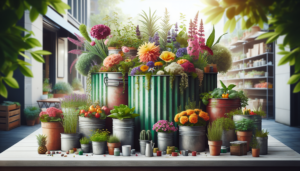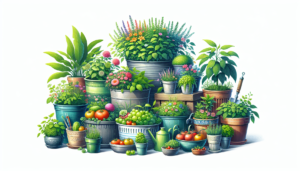
Looking to add some greenery and beauty to your garden but worried about the scorching summer heat? Look no further! In this article, we will introduce you to ten amazing heat-tolerant container plants that will thrive and flourish even in the hottest of temperatures. Whether you have a sunny balcony, a cozy patio, or a small backyard, these plants are perfect for adding a touch of nature and color to your space without the worry of them wilting away. So, grab your gardening gloves and get ready to create a stunning oasis with these heat-resistant beauties!
1. Agave
1.1 Description and Characteristics
Agave plants are succulents known for their fleshy, evergreen leaves that come in various shapes and sizes. They are native to arid regions and are well-adapted to hot and dry climates. Agave plants can range from small rosettes to larger, architectural forms with long, spiky leaves. Some varieties also produce flowers on tall stalks. These plants are prized for their unique and striking appearance, making them popular choices for container gardening.
1.2 Growing Conditions
Agave plants thrive in full sun and well-draining soil. They are extremely drought-tolerant and can withstand intense heat and prolonged periods of dryness. When it comes to soil, they prefer sandy or rocky soil with good drainage. Avoid over-watering, as excessive moisture can lead to root rot. Agave plants are also tolerant of various soil pH levels and can thrive in both alkaline and acidic conditions.
1.3 Care and Maintenance
Caring for agave plants is relatively low-maintenance. Once established, they require minimal watering and can largely fend for themselves. Watering should be done sparingly, only when the soil is completely dry. Over-watering can cause the roots to rot, so it’s important to strike a balance. Agave plants also benefit from occasional fertilization during the growing season, but excessive fertilization can lead to leggy growth.
1.4 Container Selection and Placement
When selecting a container for agave plants, choose one with good drainage to prevent waterlogging. Terracotta pots or containers made from other porous materials are ideal. As for placement, agave plants need full sun to thrive, so choose a sunny spot for your container. They can also tolerate some shade, but the foliage color may be less vibrant. Remember to provide ample space for the agave plant to grow, as some varieties can become quite large. Regularly inspect the container for any signs of overcrowding and consider repotting if necessary.
2. Bougainvillea
2.1 Description and Characteristics
Bougainvillea is a tropical vine native to South America. Known for its vibrant and showy bracts, the actual flowers are small and inconspicuous. Bougainvillea can be found in a range of colors including pink, purple, red, and orange. The plants are fast-growing and can quickly cover trellises, walls, or fences with their colorful display. Bougainvillea is a popular choice for containers as it adds a tropical touch to any garden or patio.
2.2 Growing Conditions
Bougainvillea thrives in full sun and well-drained soil. It is highly heat-tolerant and can withstand high temperatures and intense sunlight. These plants prefer slightly acidic to neutral soil pH levels. In areas with colder climates, bougainvillea can be grown in containers and brought indoors during the winter months. However, they generally prefer temperatures above freezing.
2.3 Care and Maintenance
Bougainvillea requires regular watering, especially during hot and dry periods. Ensure that the soil is well-drained to avoid waterlogged roots. Fertilize the plants every few weeks during the growing season to promote healthy growth and abundant blooms. Pruning is also important to maintain the desired shape and size of the plant. It is best to prune bougainvillea after the flowering period to encourage new growth.
2.4 Container Selection and Placement
When choosing a container for bougainvillea, opt for one that is larger and has good drainage. The plant has an extensive root system, so it needs ample space to grow. Terracotta pots or containers made from breathable materials are a good choice. Bougainvillea plants require full sun to flourish, so select a location that receives at least 6 hours of direct sunlight per day. Placing the container in a spot with good air circulation helps prevent fungal diseases and encourages healthy growth.
3. Lantana
3.1 Description and Characteristics
Lantana is a perennial flowering plant that produces clusters of small, colorful flowers. These flowers come in shades of pink, orange, yellow, and white, attracting butterflies and other pollinators. Lantana plants have a spreading growth habit, making them suitable for containers, hanging baskets, or as ground cover in gardens. They are drought-tolerant and can handle high temperatures, making them ideal for hot climates.
3.2 Growing Conditions
Lantana thrives in full sun and well-drained soil. It is highly adaptable and can tolerate a wide range of soil types, including sandy or loamy soil. These plants prefer slightly acidic to neutral soil pH levels. Lantana is known for its heat and drought tolerance but will benefit from regular watering during dry periods. They are also frost-sensitive and may need protection or be brought indoors during colder months in regions with freezing temperatures.
3.3 Care and Maintenance
Caring for lantana plants is relatively easy. Regular watering is important, particularly during periods of drought, to keep the soil evenly moist. However, avoid over-watering to prevent root rot. Lantana benefits from occasional pruning to encourage bushier growth and maintain its shape. Deadheading faded flowers can also promote continuous blooming. Applying a slow-release fertilizer during the growing season can provide additional nutrients for healthy growth and vibrant blooms.
3.4 Container Selection and Placement
Choose a container that provides good drainage for lantana plants. The size of the container should allow for the plant’s spreading growth habit. Terracotta pots or containers made from breathable materials are suitable options. Lantana requires full sun to thrive, so select a location that receives at least 6 hours of direct sunlight per day. Placing the container in a spot with good air circulation helps prevent fungal diseases. Lantana can also be grown as a hanging plant or cascading down from taller containers for added visual interest.







